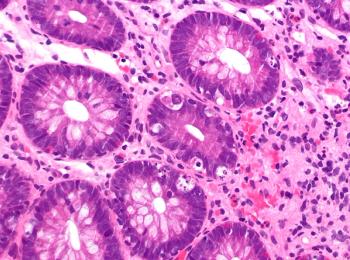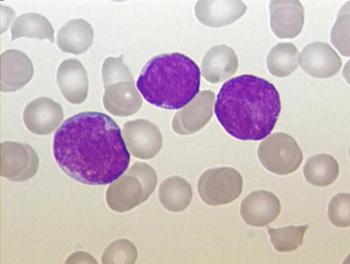
- ONCOLOGY Vol 22 No 4
- Volume 22
- Issue 4
Refractory CML: Not All Forms of Resistance Are Equal
The introduction of the tyrosine kinase inhibitor imatinib mesylate (Gleevec) has profoundly changed the treatment paradigm for patients with chronic myelogenous leukemia (CML).
The introduction of the tyrosine kinase inhibitor imatinib mesylate (Gleevec) has profoundly changed the treatment paradigm for patients with chronic myelogenous leukemia (CML). The majority of patients diagnosed with CML in first chronic phase can expect to achieve a complete cytogenetic response, with an associated very low risk of progression to accelerated phase or blast crisis, as was shown in the International Randomized study of Interferon and STI571 (IRIS) trial. In the most recently published follow-up data, presented at the 2007 American Society of Hematology (ASH) meeting in Atlanta, 66% of all patients originally randomized were still treated with imatinib on study, and the estimated progression-free survival at 72 months was an impressive 93%.[1]
Levels of Complexity
As is eloquently pointed out in the paper by Quints-Cardama and Cortes, patients who fail to achieve an optimal response or who show evidence of disease progression while treated with imatinib pose a particular challenge for practicing oncologists. The authors follow the recent recommendations of the European LeukemiaNet for defining resistance to imatinib as well as suboptimal response. Sound as these recommendations may be, an additional level of complexity might exist because, in all likelihood, not all forms of resistance are equal. A patient who fails to ever achieve a complete hematologic response in all likelihood has a prognosis for response to a second-generation tyrosine kinase inhibitor (TKI) that is quite different from a patient who loses a major molecular response but is in ongoing complete cytogenetic response.
The studies that resulted in recent US Food and Drug Administration (FDA) approval of two second-generation TKIs (dasatinib [Sprycel] and nilotinib [Tasigna]) all enrolled patients that fulfilled the criteria for resistance, but the studies were not stratified to differentiate between primary and secondary resistance or to stratify patients based on the nature of their resistance profile (hematologic, cytogenetic, etc). To a large extent, this remains an unexplored territory, and clinicians should be aware that recommendations are in flux as new data accumulate. With that caveat in mind, the paper by Quints-Cardama and Cortes provides an excellent review of the state of the art for patients with resistant or refractory disease.
Role of Stem Cell Transplant
The authors briefly mention the group of patients with the BCR-ABL1 T315I mutation that provides profound (primary) resistance against all presently available TKIs. Obviously, allogeneic stem cell transplantation should be strongly considered for these patients, if they are felt to be appropriate candidates for the procedure. For the majority of patients, stem cell transplantation will not be a viable option, and novel agents are urgently needed to address their needs. Encouraging results have been reported in clinical trials studying the use of aurora kinase inhibitors, as these agents appear to be active even in patients with the T315I mutation.[2]
Most other patients with resistant or refractory chronic phase disease should be treated with a second-generation TKI, as recommended by Quints-Cardama and Cortes. The authors note that the 2-year survival of patients with chronic phase CML is better when subsequent therapy consists of a second-generation TKI as opposed to stem cell transplantation, but that statement requires some comment.[3]
The conclusion is based on a retrospective review of patients who failed imatinib therapy at the University of Texas M.D. Anderson Cancer Center for a variety of reasons. The 2-year survival of 40 patients who were switched to dasatinib or nilotinib was compared with the outcome of 10 patients who underwent allogeneic stem cell transplantation. No data are presented as to why allogeneic stem cell transplantation was selected for some patients and not for others, and it is entirely possible that information other then the availability of an HLA-matched donor (such as the reason for failing imatinib therapy) played an important role in that decision. In addition to this potential source of bias, it should come as no surprise that the short-term survival with a transplant strategy is inferior to a strategy that relies on a second-generation TKI because of early transplant-related mortality. This obviously does not exclude the possibility that long-term survival will eventually be better with allogeneic stem cell transplantation.
As Quints-Cardama and Cortes correctly point out, the prospects are much grimmer for patients who develop refractory or resistant disease associated with progression to accelerated phase or blast crisis. Although second-generation TKIs might induce a hematologic or cytogenetic remission, remissions are usually not very long-lasting. For most patients, allogeneic stem cell transplantation should be strongly considered once progression to accelerated phase or blast crisis has been documented. Use of a second-generation TKI might help to reduce disease burden at the time of transplant and to allow for the logistical arrangements (donor identification, insurance approval) that are necessary prior to stem cell transplantation.
Monitoring Strategy
Most importantly, the paper by Quints-Cardama and Cortes emphasizes the need for an active monitoring strategy for all CML patients treated with imatinib. The introduction of imatinib has substantially changed the treatment paradigm for CML, and most patients are now diagnosed and managed by community oncologists. The molecular techniques needed for optimal response monitoring are not yet widely available. Furthermore, no consensus has been reached on a standardized method to perform quantitative polymerase chain reaction (PCR) studies, making interlaboratory comparisons of outcomes difficult. Physicians involved in the care of CML patients should be aware of these issues and should coordinate their monitoring strategy with a laboratory that can provide reliable quantitative PCR services.
Finally, many questions pertaining to optimal management of the CML patient remain unanswered. Physicians should be encouraged to participate in clinical trials or to refer patients for participation in clinical trials, so that we continue to work toward that single goal of effective and low-toxicity therapy for all patients with CML.
Financial Disclosure: Dr. DeVetten is a member of the advisory board for Bristol-Myers Squibb and Novartis.
References:
References
1. Hochhaus A, Druker BJ, Larson RA, et al: IRIS 6-year follow-up: Sustained survival and declining annual rate of transformation in patients with newly diagnosed chronic myeloid leukemia in chronic phase treated with imatinib (abstract 25). Blood 110:15a, 2007.
2. Giles F, Cortes J, Bergstrom DA, et al: MK-0457, a novel aurora kinase and BCR-ABL inhibitor, is active against BCR-ABL T315I mutant chronic myelogenous leukemia (abstract 163). Blood 108:52a, 2006.
3. Kantarjian H, O’Brien S, Talpaz M, et al: Outcome of patients with Philadelphia chromosome-positive chronic myelogenous leukemia post-imatinib mesylate failure. Cancer 109:1556-1560, 2007.
Articles in this issue
over 17 years ago
SP1049C Is Granted Orphan Drug Status for Gastric Cancerover 17 years ago
Epothilones: Clinical Update and Future Directionsover 17 years ago
Emergence of the Epothilonesover 17 years ago
Evolving Role of the Epothilonesover 17 years ago
Sorting Out the Targeted-Agent Combinations for Colorectal Cancerover 17 years ago
Second-Generation TKIs in Chronic Myelogenous LeukemiaNewsletter
Stay up to date on recent advances in the multidisciplinary approach to cancer.

















































































